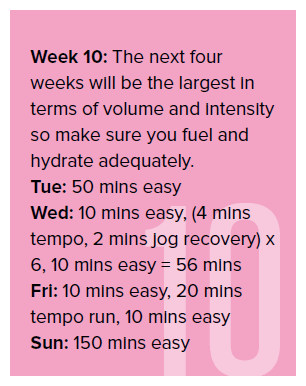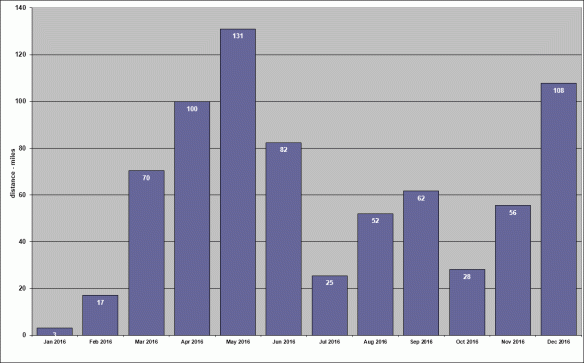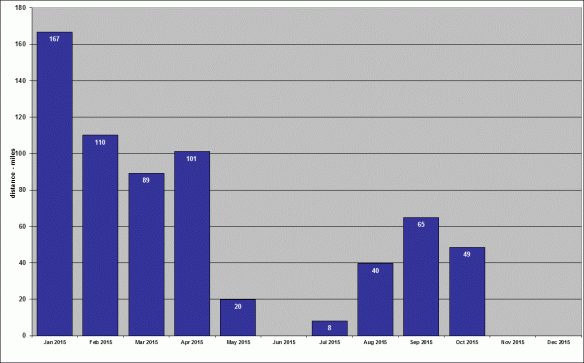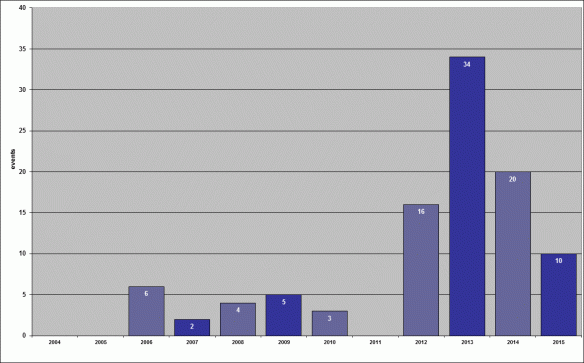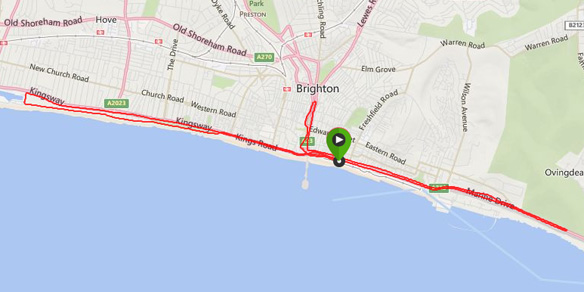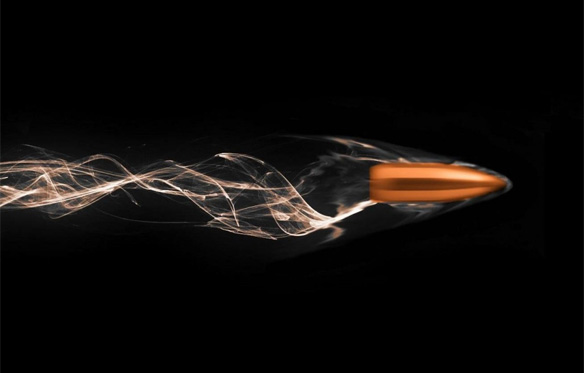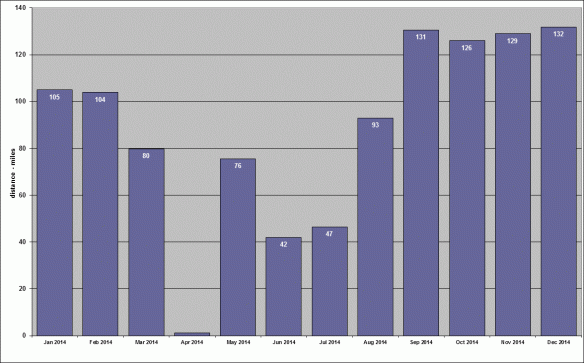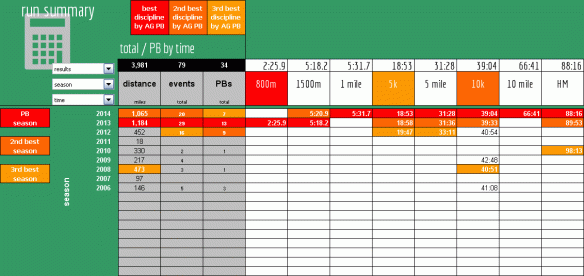Through the trees, To where I am
Following February’s Brighton Half Marathon I had a clear plan for the intervening period leading up to yesterday morning’s Paddock Wood Half Marathon – one week of recovery, two of hard training and the final fortnight tapering to yesterday’s race. By the end of the first three and a bit weeks my plan had begun to go distinctly agley. I faired a little better in the final fortnight …
week #4
| Tue 17 |
7.1k easy @ ~4:39/km |
| Wed 18 |
9k easy @ ~4:53/km |
| Thu 19 |
10.7k easy @ ~4:46/km |
| Sat 21 |
11.5k easy @ ~4:45/km |
| Sun 22 |
2.4k warm up
8k tempo @ ~4:01/km
2.7k warm down |
This was quite a good week given what had gone before. If I had been able to execute my five week plan exactly as intended then week three would have looked much like this albeit with a longer run on the Thursday.
week #5
| Mon 23 |
5.5k easy @ ~4:49/km |
| Thu 26 |
8k easy @ ~4:45/km |
| Sun 29 |
Paddock Wood Half Marathon |
Unfortunately my easy run on Monday the twenty third was characterized by soreness on the outside of my left foot; kind of at the angle between the side and the sole of my foot. My best diagnosis is that it is some kind of peroneal pain – perhaps peroneal tendonitis – brought on by the exuberance of the previous day’s tempo run. With this in mind I deferred my second run of the week to Thursday and, still erring on the side of caution, skipped the “pre-race carb load stimulus” workout I had planned for Saturday; to repeat what I had done the day before Brighton.
Into the Paddock, (Not the original libretto)
I planned to retain several of the tweaks to race day that I introduced at Brighton; modifying some slightly in light of my experience and in a spirit of experimentation. I again ate a normal breakfast on race day having set my alarm a little earlier to allow more time between eating to racing; I cut ‘digestive transit’ a little fine at Brighton. I intended, but completely forgot, to make a flask of strong coffee to drink close to race start. I did remember to take Clif Shot Bloks with me; planning to to eat one on the start line and one at each of the four on course water stations. (I had eaten just three, all on the move, during the race at Brighton.)
My journey to Paddock Wood went reasonably well, the loss of one hour’s sleep to the changeover to British Summer Time notwithstanding. I arrived in the official race car park at about 8:40 and was very fortunate to be flagged down by another runner who advised there was no point joining the queue to park as there were no spaces left. I improvised a parking spot close to the entrance and, by the time I got out of my car, the gate to the car park had been closed and the still constant flow of runner-bearing cars was being turned away. Whether there was a second car park I don’t know, but I was thankful not to have that problem to deal with.
Into the Woods, I have to go
After walking a mile in an ever broadening stream of runners I found the start/finish line, a changing marquee, an excellent bag check operated by the local Girl Guides and the usual portaloo ghetto. Fortunately, it turned out that I didn’t have to go and so the realisation that I had forgotten to pack a toilet roll in my race bag wasn’t exposed.
For once I was able to take my place in the starting pens with several minutes to spare. I relaxed and rehearsed my pace plan – start at 4:10/km and increase by 1 second per kilometre until I reach 4:02/km and then maintain to achieve an overall average pace of 4:04/km and a finish time of 85:42 – my jantastic goal was 85:47.
Since Shot Bloks come in packs of six I decided to eat two on the start line and retain the rest for the water stations.
The way is clear, The light is good
The race announcer described and then executed the start procedure – whistle first and then gun – and we were off. The first two kilometres were slightly uphill and I felt comfortable as I ran my opening goal paces of 4:10 and 4:09. Early in kilometre three the climb crested and the course began a gentle descent. I let myself run comfortably and freely and, knowing I was descending, wasn’t too concerned that I completed the third and fourth kilometres in 4:02 and 3:57. Approaching the end of the fourth kilometre I noticed that my average pace to that point was 4:04 – my goal pace for the entire event – and realised that I no longer needed my original pace plan and could achieve my goal by simply maintaining an average pace of 4:04/km to the end.
For the remainder of the first half of the race this new plan went well …
| kilometre |
split |
cumulative average pace |
| 5 |
4:05 |
4:05 |
| 6 |
4:03 |
4:04 |
| 7 |
4:01 |
4:04 |
| 8 |
4:00 |
4:03 |
| 9 |
4:05 |
4:04 |
| 10 |
4:07 |
4:04 |
Into the woods, It’s time to go
I ate my first Shot Blok approaching the water station just beyond 5k as planned and as I anticipated the next station just beyond 10k I started to feel the strain for the first time. I put my second Shot Block into my mouth and willed the water station to appear. When it eventually did I took in a minimal amount of water; primarily because the water was in plastic cups* and also because, with light rain and cool temperatures throughout, I didn’t feel thirsty. It was at around this point that I saw a friendly face** calling half way times from the side of the course. Hearing “42:54” I knew I was on target for my goal time, but I was also aware that progress was becoming difficult.
I hadn’t studied the course beyond checking the number and approximate distances of the water stations and had simply believed the course was fast and flat as advertised. At half way my watch still showed 4:04 as my average pace, but I knew I had dropped a few seconds completing kilometres nine and ten. I felt like I was climbing much of the time and began to wonder just how great the descent during kilometres three and four had been? Was there now an equivalent ascent, albeit much more subtle, stretching out ahead of me? At the end of kilometre twelve I saw my average pace slip to 4:05 and tried to hold it there. Almost immediately, it seemed, it slipped again to 4:06 and I resolved to try and hold it there. I knew my existing PB equated to an average pace of 4:06/km and rationalised that if I could maintain this as my average pace a fast finish could still deliver a PB. I was unsure whether the main impediment to my progress was the undulation or the wind. As I ran I decided that it was the climbs although the wind did become a more and more significant factor as my race went on. [Only when checking my run profile today did I discover that, after the climb and descent in the first four kilometres which I correctly identified, the course is relatively flat. The wind was clearly much more significant than I judged at the time.]
The woods are just trees, The trees are just wood
The physical struggle to maintain my pace and the mental struggle to understand why I was finding it so hard took their toll. If you haven’t realised until this point that my section headings are (mostly) from Stephen Sondheim’s “Into The Woods” you may just be experiencing a hint of the disorientation I felt. I saw my average pace slip quickly away from anything that might produce a PB and revised my goal once more; an average pace no slower than 4:10/km to ensure a finish time just inside 90 minutes. I did not want to finish on the wrong side of such a significant barrier. [Such was my disorientation; only when writing this post did I realise 4:10/km is actually equivalent to 87:54!]
I fought the despair when I saw splits in the teens and twenties and put all my effort into minimizing my retardation. I stopped checking my progress in terms of distance as I had no energy or will to try to do anything other than wrestle with my average pace. I was disheartened further when runners whom I’d recently passed began to reappear at my shoulder. I used these for cover from the wind for some minutes before re-passing them and attempting to push my pace towards something that would improve my anticipated finish time. Only to have to admit defeat and tuck back in behind them when they appeared again.
The table below shows my splits, and the deterioration of my average pace, during the second half of my race. I wasn’t aware of the detail of this at the time and couldn’t have told you without my Garmin’s hindsight which kilometres were the ones where my pace failed me most. All of kilometres thirteen through nineteen merge in my mind in a blur of wind, emotional turmoil and the distinctive shirts of three or four runners who passed and re-passed me. I fought to hold on to them for the remainder of the race. One did pull significantly away, but the others and I formed a group and, I think, we sub-consciously took turns in pulling each other along. Seeing more and more split times outside 4:10 I finally saw my average pace slip to 4:09 and checked the distance remaining. I had just completed kilometre nineteen.
| kilometre |
split |
cumulative average pace |
| 11 |
4:10 |
4:04 |
| 12 |
4:06 |
4:05 |
| 13 |
4:09 |
4:05 |
| 14 |
4:14 |
4:06 |
| 15 |
4:20 |
4:07 |
| 16 |
4:10 |
4:07 |
| 17 |
4:15 |
4:07 |
| 18 |
4:26 |
4:08 |
| 19 |
4:15 |
4:09 |
| 20 |
4:18 |
4:09 |
| 21 |
3:55 |
4:08 |
I decided that the best tactic was now to simply race the three shirts around me. I didn’t look at my watch again. Throughout kilometre 20 I made sure that I didn’t lose my place within the group. As my watch chimed for the start of kilometre 21 one runner, in a black shirt, began to move off the front of our group. I made sure I went with him confident that with just over a kilometre to go I would be able to find a sprint finish. Not that my motivation was to beat him personally, but to use the impetus of our micro-competition to extract all that I could from myself.
As we approached the start/finish area I recognised the section of the course that had formed part of my walk to the race when I had noticed the “400m to go” and “200m to go” signs. I’m not quite sure when I started my sprint. Possibly around the 200m sign. I re-passed the runner in black, slowed just a little on the sharp turn in towards the finish line, and pressed hard again around the more gentle arc to the line. I stopped my watch and had only just recovered enough to acknowledge the congratulations of the runner in black when he appeared beside me.

I sort of hate to ask it, But do you have a basket?
race data summary
| official finish time |
chip 87:14 (gun 87:34) |
| target |
85:47 – 1:27 outside |
| splits |
pace
4:10, 4:09, 4:02, 3:57, 4:05,
4:03, 4:01, 4:00, 4:05, 4:07,
4:10, 4:06, 4:09, 4:14, 4:20,
4:10, 4:15, 4:26, 4:15, 4:17,
3:55 (final full km), 0:16 (final 97.5 metres)
approx HR
145, 152, 153, 155, 157,
159, 159, 160, 159, 160,
157, 159, 159, 159, 156,
159, 158, 156, 158, 159,
162 (final full km), 167 (final 97.5 metres) |
| biometric summary |
average HR – 157
max HR – 169 (estimated personal maximum – 172)
average cadence – 182
approx start weight – 69.6kg |
positions by chip time
(gun time) |
overall – 132 (131) out of 2061
gender – 126 (125) out of 1246
category VM40-49 – 43 (44) out of 462 |
Once I’d collected myself, my bag and some flapjack I walked slowly, and fairly gingerly, back to my car. Neither of my recent niggles had bothered me during the race and even post race both feet/ankles felt no more than sore and tired. Well, very sore and very tired. However by the time I arrived home I seemed to have acquired a cold. I continued to eat and rehydrate and took a single dose each of both paracetamol and ibruprofen to combat my cold symptoms and my general post race aches. I spent much of the afternoon alternately dozing and feeling sorry for myself as I used almost half a box of tissues managing my cold. I went to bed feeling quite low, anticipating several days under the weather.
Today though I woke with no cold symptoms whatsoever, I ran a relatively comfortable 4k recovery and briefly swam with my 5 year old which is always good physiotherapy for my legs and feet. And I am now feeling quite rejuvenated, thoroughly positive and enthusiastic about my running again. It looks like I’ll make it out of the woods yet.
Until next year anyway. When, I hope, my preparation will have been more optimal. And by which time I will be in the VM50-59 age category where, I couldn’t help but check, my time this year would have placed me 9th out of 212 😉
* I realise now how much I appreciated having bottled water with a sports cap at Brighton from which I found it much easier to drink a significant volume.
** Mick Firth, coach at South London Harriers, whom I recognised from a relatively brief period in early 2010 when as part of a group of athletes I trained with him in Crystal Palace Park.



